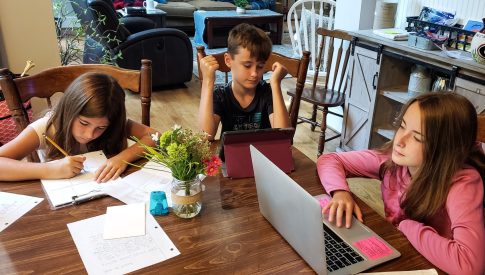Primary 5 - Second Level Literacy
Online Literacy Lessons for Primary 5 Students in Scotland.
Scottish Online Lessons begin Primary Five Writing with an exploration of nouns, learning what a common noun is, what a proper noun is and that a proper noun starts with a capital letter. Pupils will be able to identify common and proper nouns within a sentence and use a capital letter when writing proper nouns.
Pupils learn what an adjective is, that it describes a noun and be able to use the correct adjective to describe a noun within a sentence. They learn how to use a pair of adjectives to describe a noun.
They learn that singular means only one and that plural means more than one. They learn how to form plurals of regular words and words ending in s, ss, x, z, sh and ch and to write sentences containing a plural noun.
We develop their learning of adverbs, learning what an adverb is and that it tells us how, when or where a verb action happens. They learn to identify an adverb in a sentence, use an adverb to describe how, when or where a verb action happens and use an appropriate adverb to describe a verb within a sentence.
Our indefinite article lessons teach what an indefinite article is and when to use the correct indefinite article to match the word it applies to.
They learn what a comparative adjective is and the three different ways a comparative adjective can be formed. They learn to form comparative adjectives using the appropriate method and use them in a sentence.
Pupils explore what a connective is, how to use the connectives and and but and use them to join sentences together.
Our Sentence Properties lessons show that a sentence starts with a capital letter and ends with a punctuation mark. They learn that all sentences contain a subject and a verb and most sentences also contain an object, Pupils learn to say all the properties of a sentence, identify the subject, object and verb within a sentence and write sentences of their own which contain all sentence properties.
Contraction lessons show what a contraction is, that an apostrophe takes the place of a missing letter or letters and pupils learn where to place the apostrophe in a contraction. They learn to say what a contraction is, when they should use one, be able to form one from two words and write a contraction properly, placing the apostrophe in the correct place.
Lessons on homophones describe what a homophone is, that the words 'to', 'two' and 'too' are homophones, what their meanings are and how to use them correctly. Pupils learn to say what a homophone is, what the meanings of 'to', 'two' and 'too' are and be able to use them correctly in a sentence.
We teach prepositions, explaining what one is and how to use the correct preposition in a sentence. Pupils learn to say what a peropsition is, identify a preposition in a sentence and choose the correct preposition to show the relationship between two things in a sentence.
Our synonym lessons explain what a synonym is and how to use it in writing. They learn to say what a synonym is, replace words in a sentence with an appropriate synonym and choose the best synonym to use in a sentence.
Learners discover what an antonym is and that it is used to express the opposite of a word. They learn what an antonym is, find the antonym of given words and find antonyms of words which they choose.
They learn that a verb is a 'doing' word and that every sentence needs a verb. Pupils learn what a verb is and why we need them. They learn to identify verbs, identify verbs in a sentence and use a verb in a sentence.
Verb Family Names lessons teach what a verb is, that all verbs are part of a verb family and how to identify parts of a verb family. Pupils learn to say what a verb is, identify a verb family name and recognise different parts of a verb family.
Present-tense lessons teach what a verb is, what a verb tense is and how to form the present tense of a verb. Pupils will learn to match a verb with a subject in the present tense and to write a sentence with a verb in the present tense.
Past tense lessons show what a verb is, what a verb tense is and how to form the past tense of a verb. Pupils learn to say what a verb is, what a verb tense is, that they can form the past tense in two ways and write a verb in the past tense in a sentence.
When learning verb and person agreement, pupils learn the meaning of the term and how to make a verb and subject agree. They learn to say what verb and subject agreement is and make a verb agree with the person doing the verb.
Verb future-tense lessons explain what a verb is, what a verb tense is and how to form the future tense of a verb. Pupils learn to say what a verb is, what a verb tense is and form the future tense of a verb. They learn to write a verb in the future tense within a sentence.
Our Writing-to-Persuade lessons explain what the term writing to persuade means and to know when to use persuasive writing. They learn the main tools of persuasive writing and how to use them. They learn what 'writing to persuade' means, when it should be used and how to use the main tools. They learn to complete a piece of writing using persuasive tools.
Primary Five Fact and Opinion lessons expand on what a fact is, what an opinion is and how to know the difference between fact and opinion. Pupils learn to say what a fact is, what an opinion is and tell the difference is between a fact and an opinion.
In our Editing and Improving Sentences lesson, pupils are taught how to improve their sentences and to realise that by improving their sentences their writing will improve. They learn to say what they should do to improve their sentences and be able to review, edit and improve their sentences.
Our reading lessons begin with comprehension strategies. Learners discover what comprehension means, what a literal question is and what an inferential question is.
They learn to say why comprehension is important, what a literal question and an inferential question is and identify and answer them from a passage.
They learn what skimming means, what scanning means and how to both skim and scan a text. They learn to say what skimming and scanning are, what the difference is and be able to do both.
In Decoding Tricky Words pupils are taught how to use strategies for decoding tricky words and know how to use those strategies to understand tricky words. They learn to use strategies to decode and understand tricky words.
Predicting involves teaching what predicting means, to know why it is important to make predictions and to know strategies to help predict what comes next. Pupils learn to say what prediction means, what strategies to use to predict a text and to predict what is coming next in a text.
We teach what summarising is, why it is important and how to do it. Pupils will understand what summarising is, why it is important and be able to use what they learn to summarise a non-fiction article.


"It's bright and colourful, easy to read, and extremely easy to use unlike most textbooks or online learning websites" Daisy, S3 PupilSign Up & Learn Today

